|
Galerella
pulverulenta (Cape grey mongoose, Small grey mongoose)
[= Herpestes pulverulentus]
klein grysmuishond, Kaapse grysmuishond [Afrikaans];
Kleinichneumon [German];
mangouste gris du Cap [French]
Life
>
Eukaryotes >
Opisthokonta >
Metazoa (animals) > Bilateria > Deuterostomia >
Chordata > Craniata > Vertebrata (vertebrates) >
Gnathostomata (jawed vertebrates) > Teleostomi (teleost
fish) > Osteichthyes (bony fish) > Class:
Sarcopterygii (lobe-finned fish) > Stegocephalia
(terrestrial vertebrates) > Reptiliomorpha > Amniota >
Synapsida (mammal-like reptiles) > Therapsida > Theriodontia
> Cynodontia > Mammalia (mammals)
> Placentalia (placental mammals) > Laurasiatheria
> Ferungulata > Ferae > Carnivora > Family:
Herpistidae (suricates and mongooses)
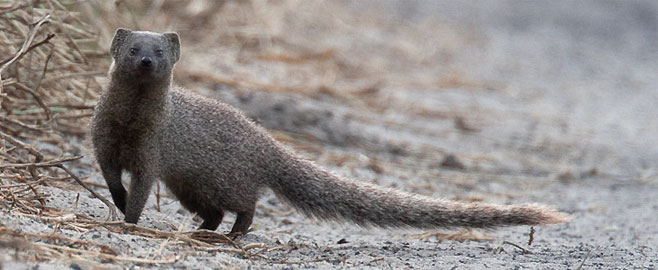 |
|
Galerella
pulverulenta (Cape grey mongoose, Small grey mongoose), Strandfontein Sewage
Works, Cape Peninsula. [photo
Robert
Lewis ©] |
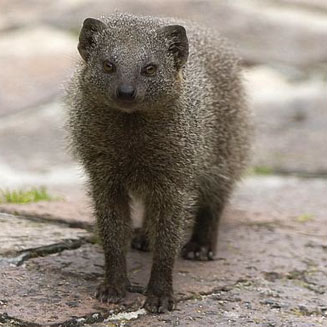 |
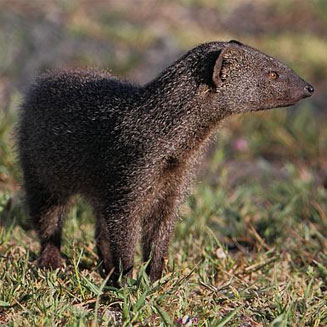 |
|
Galerella
pulverulenta (Cape grey mongoose, Small grey mongoose), Rondevlei Nature
Reserve, South Africa. [photo Trevor
Hardaker ©] |
Galerella
pulverulenta (Cape grey mongoose, Small grey mongoose), Strandfontein Sewage
Works, Cape Peninsula. [photo Trevor
Hardaker ©] |
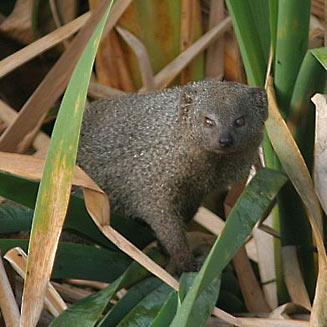 |
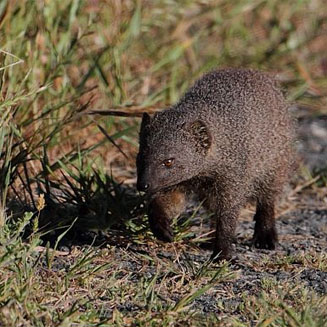 |
|
Galerella
pulverulenta (Cape grey mongoose, Small grey mongoose), Strandfontein Sewage
Works, Cape Peninsula. [photo Trevor
Hardaker ©] |
Galerella
pulverulenta (Cape grey mongoose, Small grey mongoose), Strandfontein Sewage
Works, Cape Peninsula. [photo Trevor
Hardaker ©] |
Endemic to southern Africa, occurring in habitats
varying from scrubland to forest. However, it is not found in the
Savanna Biome. Eats mainly invertebrates but also preys on birds,
mammals and reptiles.
Distribution and habitat
Widespread south of the Orange River, through
Lesotho, southern Free State and marginally into Kwazulu-Natal. Has
a wide habitat tolerance, from forest to open scrubland, but is
absent from savanna habitats.
Identification
As its common name suggests the small grey
mongoose is one of the smaller mongoose species and is uniformly
grey in colour. The shade of grey may vary from light to dark and
the coat has a grizzled appearance. In the north-west areas the
animals may be more brownish in colour. The legs are a darker grey
than the rest of the body. It has a typical elongated mongoose
body-shape, the head is long and with a pointed muzzle. The ears are
small and rounded and situated on the sides of the head. The tail is
long and bushy. The teeth show adaptations for both cutting and
crushing.
Size
Body length 55-69 cm; weight range 0.5
–1.0 kg.
Dental Formula
I C C P P M M =
38 =
38
General behaviour
The mongoose is diurnal but tends to rest up
during the hottest time of the day. Caution and camouflage are
important for survival. Their predators include larger predatory
mammals and raptors. They are usually solitary but may be seen in
pairs or with young. They are predominantly bush dwellers, and may
occasionally climb trees while foraging or when threatened. Poor
diggers they utilize piles of rocks, crevices, deserted burrows and
hollows in tree trunks for shelter when there is not sufficient bush
cover. Frequently seen crossing roads, they move at a quick trotting
pace on their short legs and hold their tails close to the ground.
Home ranges of animals overlap and it is not certain if this species
is territorial. Often they live in close association with man e.g.
under the floors of outbuildings and even live successfully on the
fringe of suburbia.
Food
Predominantly invertebrates (mainly insects)
and small rodents, also includes amphibians, birds (including eggs
and young from nests), reptiles and some wild fruits. Birds loath
these animals - in the Cape if you hear a whole lot of birds giving
their alarm calls, it is usually either a snake or the Cape grey
mongoose.
The Cape grey mongoose is predominantly
insectivorous but also carnivorous. Insects are caught on the ground
and then held down with the forefeet and eaten. Large prey such as
rodents are stalked and then pounced on and bitten. The killing bite
is then given to the head. Larger prey items are held down with the
forefeet and then torn into bite size pieces with the teeth.
Reproduction
Litters of 1 – 3 young are born from August to
December and hidden in burrows, rock crevices or tree hollows. At
birth the pups are fully furred, but their eyes and ears are closed,
opening after about a fortnight. Females are not seen accompanied by
young. This is because the young remain in the breeding burrow until
they are fully weaned, only leaving its shelter when they are
capable of looking after themselves.
Life span
8-9 years
Conservation
Mongooses are widespread and a successful group
and no species is known to be in danger of extinction.
Text by Denise Hamerton |
